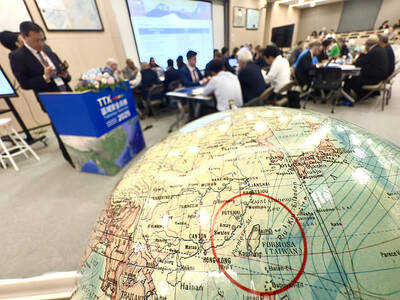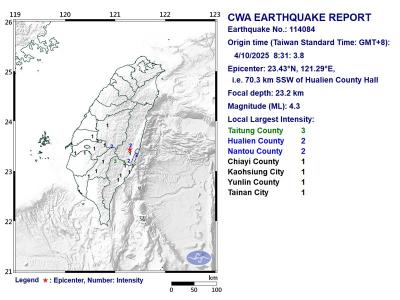Council for Cultural Affairs (CAA) Vice Chairman Wu Chin-fa (吳錦發) yesterday said that the council will start to review the historical value of Taiwan's only leprosy sanatorium, Happy Life Lo Sheng Sanatorium (樂生療養院) in Hsinjhuang, Taipei County, a move closer toward preserving the 70-year-old sanatorium.
"We had a meeting yesterday [Thursday] regarding this issue. We will abide by the newly revised Cultural Heritage Preservation Law (文化資產保存法) to preserve the sanatorium as a historical site," Wu told the Taipei Times yesterday.
Originally plan, the construction of the Taipei Mass Rapid Transit's (MRT) Hsinjhuang Line was set to force the demolition of the sanatorium and require over 300 patients to move.
In the face of the demolition plans, in desperation some patients last year began campaigning to save their home, sending petitions to various government agencies, including the Taipei County Government, the Executive Yuan, and the CAA.
To strike a balance between the public's interests in the MRT project and individual human rights, the Executive Yuan in October invited experts to study alternative plans that would allow the MRT line and the sanatorium to co-exist.
alternative plans
Last December, the panel of experts suggested the government could preserve the sanatorium by moving the MRT's power plant and water treatment plant underground.
"To preserve the culturally valuable sanatorium, we will need to move the two plants underground, dismantle part of the administrative building to make room for the underground construction, and rebuild it after the project is finished," said Liu Ke-chiang (劉可強), a professor at the Graduate Institute of Building and Planning at National Taiwan University, whom the Executive Yuan entrusted to hammer out an alternative plan.
According to Liu, the additional construction would cost the government about NT$541 million and delay the whole MRT project by about 18 months.
"The cost may sound high, but it is historically worthwhile and ecologically friendly," Liu said.
In Liu's alternative plan, the construction company would only have to excavate 847,500m3 of earth, far less than the 1.6 million cubic meters of earth estimated in the original plan.
But Taipei City's Department of Rapid Transit Systems said the price would be much higher.
Conflicting Estimates
According to the department's report to the Executive Yuan last December, changing the original plan to preserve the sanatorium would delay the project's completion by more than three years and cost more than NT$2 billion (US$63 million), partly due to compensation that construction contractors will ask for once the project is altered.
City planning academics saw the city's claim as an attempt to dodge responsibility.
"There is still room for negotiations with the construction companies. It depends on how much effort the transportation officials want to put in," Liu said.
The CAA said that it will serve as arbiter among the different government agencies to seek a solution for both sides.
"We will talk to the Taipei County Government and the Department of Rapid Transit Systems as soon as possible," Wu said.
"I believe it won't take too long to list the sanatorium as a historical site," he said.

DEFENSE: The National Security Bureau promised to expand communication and intelligence cooperation with global partners and enhance its strategic analytical skills China has not only increased military exercises and “gray zone” tactics against Taiwan this year, but also continues to recruit military personnel for espionage, the National Security Bureau (NSB) said yesterday in a report to the Legislative Yuan. The bureau submitted the report ahead of NSB Director-General Tsai Ming-yen’s (蔡明彥) appearance before the Foreign and National Defense Committee today. Last year, the Chinese People’s Liberation Army (PLA) conducted “Joint Sword-2024A and B” military exercises targeting Taiwan and carried out 40 combat readiness patrols, the bureau said. In addition, Chinese military aircraft entered Taiwan’s airspace 3,070 times last year, up about

The Overseas Community Affairs Council (OCAC) yesterday announced a fundraising campaign to support survivors of the magnitude 7.7 earthquake that struck Myanmar on March 28, with two prayer events scheduled in Taipei and Taichung later this week. “While initial rescue operations have concluded [in Myanmar], many survivors are now facing increasingly difficult living conditions,” OCAC Minister Hsu Chia-ching (徐佳青) told a news conference in Taipei. The fundraising campaign, which runs through May 31, is focused on supporting the reconstruction of damaged overseas compatriot schools, assisting students from Myanmar in Taiwan, and providing essential items, such as drinking water, food and medical supplies,

STRICTER ENFORCEMENT: Taipei authorities warned against drunk cycling after a sharp rise in riding under the influence, urging greater public awareness of its illegality Taipei authorities have issued a public warning urging people not to ride bicycles after consuming alcohol, following a sharp rise in riding under the influence (DUI) cases involving bicycles. Five hundred and seven people were charged with DUI last year while riding YouBikes, personal bicycles, or other self-propelled two-wheelers — a fourfold increase from the previous year, data released by the Taipei Police Department’s Traffic Division showed. Of these, 33 cases were considered severe enough to be prosecuted under “offenses against public safety,” the data showed. Under the Road Traffic Management and Penalty Act (道路交通管理處罰條例), bicycles — including YouBikes and other

A magnitude 4.3 earthquake struck eastern Taiwan's Hualien County at 8:31am today, according to the Central Weather Administration (CWA). The epicenter of the temblor was located in Hualien County, about 70.3 kilometers south southwest of Hualien County Hall, at a depth of 23.2km, according to the administration. There were no immediate reports of damage resulting from the quake. The earthquake's intensity, which gauges the actual effect of a temblor, was highest in Taitung County, where it measured 3 on Taiwan's 7-tier intensity scale. The quake also measured an intensity of 2 in Hualien and Nantou counties, the CWA said.